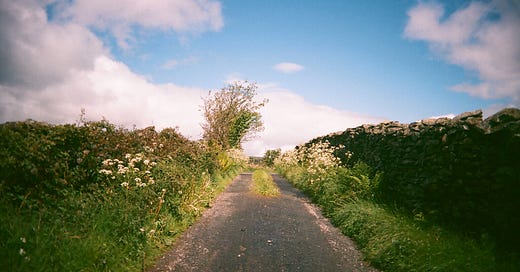A hedge witch is often known as a solitary practitioner of magic. They practice in the byways. Picking medicine off the sides of backroads. Collecting spring water by train tracks. Leaving ashes at crossroads. Sealing spells at kissing gates. Finding themselves at home in open fields, praying to the call of the owl at dusk. Dancing with Diana in the wild at night. Dreaming of oak trees whose branches sweep the golden hills, their trunks humming with honeybees.
A hedge marks a perimeter. When enclosure was formally practiced and enforced in what is now known as the United Kingdom, a hedge marked a boundary between tended land and wild land. Hedges often delineated the space where ownership ended and something else had sovereignty. A hedge exists at the margins of what is known. Hedges hold both political and magical implications for the practicing witch.
“Leveling the enclosing hedges became ‘the most common species of social protest’” throughout the 16th and 17th centuries in England. And most of these protests heavily featured women, because, “women were those who suffered most when the land was lost and the village community fell apart.” (Federici, p.73)
With the advent of capitalism came the privatization of public lands, known as the commons. The commons were wild and free areas of wilderness where human and non-human communed, where medicine and sustenance were sourced, and where our contracts with spirits (land and ancestral) were fulfilled. With restricted access to the commons, communities were less able to sustain themselves. Without direct communion and participation with the wilderness, the community struggled to support all of its members. Those who particularly struggled were women. “The social function of the commons was especially important for women, who, having less title to land and less social power, were more dependent on them for their subsistence, autonomy, and sociality.” (Federici, p. 71)
Women who were once resourced by the wilderness became socially and economically marginalized without access to it, failing to assimilate to the new demands of a capitalist society. Those women who failed to live in alignment with these strict, inanely fabricated and disastrous demands of church and state were often ostracized and have hence been called witches. The hedges that were used to mark the boundary between ownership became the precious liminal spaces that the peasantry, the poor, and women had access to. Magic blooms out of necessity.
As hedges-as-boundaries multiplied their importance as portal places grew in strength. These hedges host nettle, gorse, blackthorn, hawthorn, berries, rowan, and other sacred members of our plant kin. They became untamed and wild spaces where wild animals burrow, nest, and dwell. Within the hedge lies sustenance on a physical and spiritual level. These hedges support biodiversity amidst the culture of monocrops; an oasis for forages, pollinators, and elemental beings who exist in spaces which have been left to thrive without human intervention. These hedges became a betwixt & between place, a shred of wilderness in an otherwise tamed landscape.
A hedge witch practices their magic in these wild and untamed places. Crossing over the hedge is the practice of journeying beyond the comforts of our known and accepted reality, into the land of spirits, into connection with the sentience of our other-than-human kin. Through crossing over the hedge we metaphorically biolocate into the wilderness of the other, land that is neither here nor there, a place that exists by moving through it.
The hedge witch is both solitary and never alone. They practice within an ever evolving web of relations. We conjure and connect with the spirits of the land, our beloved dead. We cast spells with the support of wise plant allies and animal elders. We are guided by deities of place and ancient or primal goddesses who call upon us as much as we call upon them. Our magic affirms the ways we all need each other to participate in this wild cosmic dance. The more we are able to honor and respect those relationships with unseen forces, energies, and spirits, the more visible and tangible they become, and the less alone we feel.
In the same vein, the hedge witch’s role is rooted in community care. Where once the commons provided care and sustainability for a community, living in concert with Earth’s cycles, the commons now needs humanity to care for it. To leave offerings at the crossroads, to create homes for wild honey bees, to plant milkweed, and leave fresh water out for animals fleeing wildfire. For the hedge witch all of their spells and actions are routed in this relational respect. Tending to the wild spirits strengthens their resilience as much as they offer us insight and healing.
So look to the byways. Pick blackberries on the side of the country lane. Call to the rosehips beckoning to you by the edge of the road. Travel where telephone lines tower through vast prairies. Where only horizon lines exist. Wild and softly touched places. Intersecting blue highways. Cairns marking desolate wilderness trails. Where dusk lays outstretched for miles, lazing in its dull lavender veil.
I look forward to exploring the ways of the hedge witch with you all… this is a spell for greater community care for the wider web of relations we all exist within.
Love to your ancestors and to the Earth you tend
Source:
Federici, Silvia. Caliban and the Witch, 2004.





So beautifully said 🤍